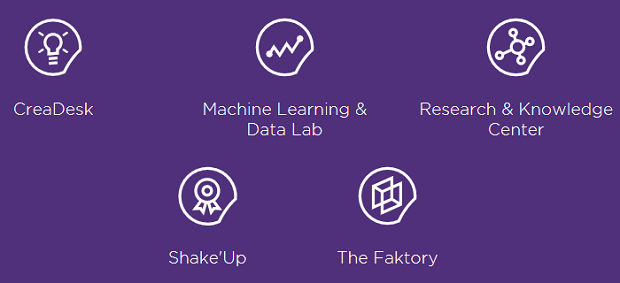Wavestone US is the North American arm of global management and IT consulting firm Wavestone. Below is our recent interview with Jeff Vail, CEO of Wavestone US:

Q: Jeff, can you tell us something more about your unique model?
A: Our unique model leverages an influential peer-to-peer culture, in that a lot of our senior consultants were former CIOs, IT leaders, and business executives who’ve been where a lot of IT and business leaders are today. We offer a practitioner’s perspective on IT strategy, cost optimization, operational improvements, cybersecurity, and business management.
For us, digital transformation isn’t a destination. It’s a forever journey. We partner with you to drive change for growth as well as lower cost and risk, and we ensure that you’re equipped and fully supported to be successful even after our initial engagement is complete. We’re about supporting the journey, and not about products and services that get you “Digital Transformation” today.
Q: You’ve recently announced the company’s complete rebranding; could you tell us something more?
A: Wavestone’s IT consultancy in the US was formerly known as WGroup, an IT consultancy firm with a 15-year history of supporting the transformations of more than 200 Fortune 1000 companies across a wide range of industries. Then, we offered only partner-level consultants—former C-suite executives who offered advice through real practitioner’s experience rather than academic recommendations.
Since the merger with Wavestone in July 2019, we now have access to a global network of more than 3,000 additional seasoned experts and dynamic talent equipped with sector-specific knowledge and expertise across business functions and technologies. As Wavestone US, we have further expanded our offerings in breadth and depth across IT strategy and planning, IT cost and run optimization, cybersecurity, business operations enhancements, and even talent solutions.
 Recommended: An Interview With Matthew Bogart Vice President Of Marketing At NexJ Systems
Recommended: An Interview With Matthew Bogart Vice President Of Marketing At NexJ Systems
Q: What are you most excited about in the industry at the moment and what future trends are you expecting to see?
A: We are most excited about the big shift. The shift in focus from ‘run’ to ‘grow’. A coalescence of technologies reduces the burden to manage the run environment including converged infrastructure, cloud, SD-WAN, and automation, among others, enabling organizations to shift energy, budget and people toward business impact IT initiatives.
Q: Who are your clients? What challenges are you helping them solve?
A: Our client base covers all industries for the most part, except for the public sector and education. We have a big resource pool to tap to serve all those industries, thanks to our consultants, many of whom are ex-practitioners with 20 to 30 years of experience across multiple industries.
Most of these companies are Fortune 1000, the breakdown roughly 80% Fortune 1000, and the other 20%, businesses trying to be among the Fortune 1000.
In terms of digital transformation initiatives, there are four main problems.
Problem No. 1: They don’t have enough time to deal with digital transformation. Digital transformation means using IT and tech in ways to differentiate the company from the competition and provide new revenue streams, business models, and business opportunities. Your typical IT function today doesn’t have the time as they’re spending way too much time, energy, money, and resources maintaining data centers and infrastructure, mainframe legacy applications, and so on.
Problem No. 2: They don’t have the right skills. The IT organization that brought the company to where it is today isn’t the same IT people need to get the company to where they need to go tomorrow. The right skills and the right operating model are not there.
Problem No. 3: The punch in the mouth for many organizations is typically mergers and acquisitions. No matter how great you plan to improve your business in any aspect, mergers and acquisitions are very prolific in our market today. For most large organizations, they’re doing multiple manifestations of M&As that have thrown a wrench into transformation plans.
Problem No. 4: Every year, you’ll read that CIOs want to align IT with the business better, and every time we start a new engagement with a company, we find that there is an insufficient business vision for IT to align to.
We’ve aligned our portfolio to knock down these barriers holding back many organizations from really progressing on their digital transformation journeys. What we’re doing is helping you streamline and use IT to drive business value. We offer a comprehensive suite of services that spans the entire lifecycle of a transformation project:
• IT Strategy & Planning – Align IT with business goals
• IT Cost & Run Optimization – Shift focus from run to grow
• IT Talent Solutions – Build a high-performing workforce
• Cybersecurity & Digital Trust – Value digital trust as a key business enabler
• Business Operations – Make operations more effective
Q: What are your plans for the future?
A: Wavestone US is looking forward to leveraging its newfound global delivery capability. As most of our clients are Fortune 1000, with international locations, they need that. We currently have a base in Philadelphia and New York, and we have every intention of expanding operations in different cities across North America to get closer to our clients and more ‘local’.
We’re also taking a more vertical approach with our clients. When you process some of these digital transformation requirements clients have, it’s often industry-specific. Healthcare organizations are trying to improve patient experience; the automotive companies are taking advantage of IoT trends, to name a few. To try and get ahead of these industry-specific trends that are ultimately going to drive these businesses, taking a more vertical approach would enable us to offer more value to our clients.

 Recommended:
Recommended: 